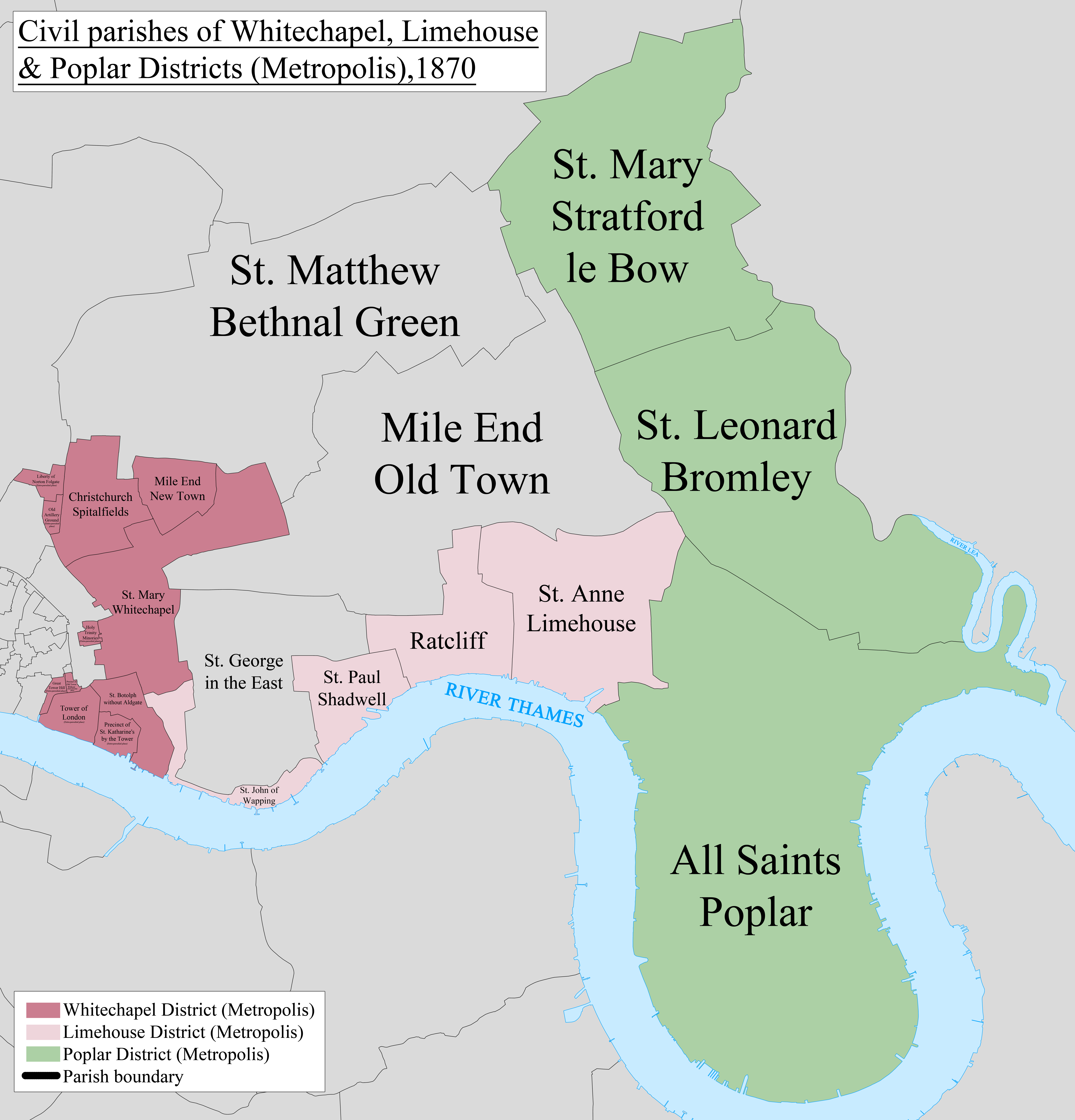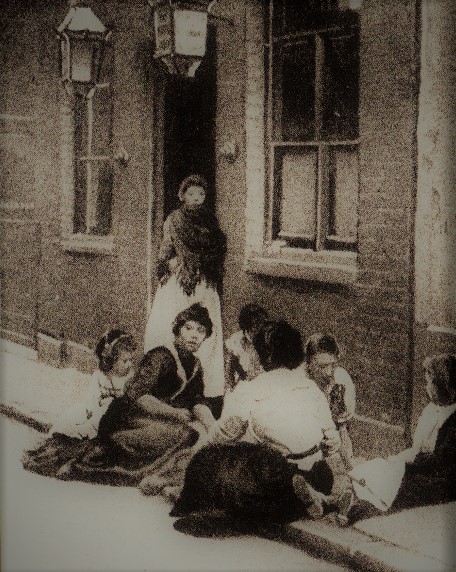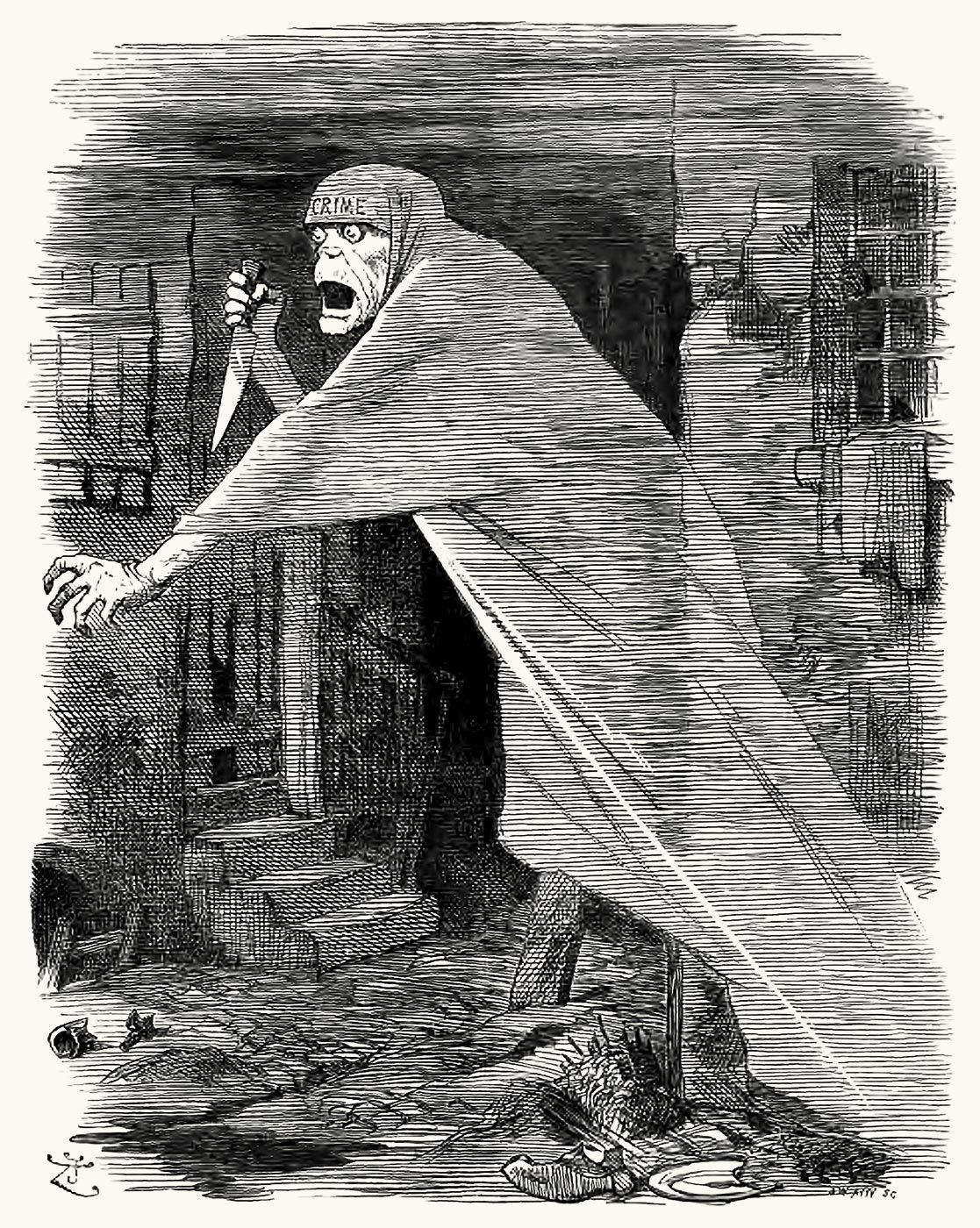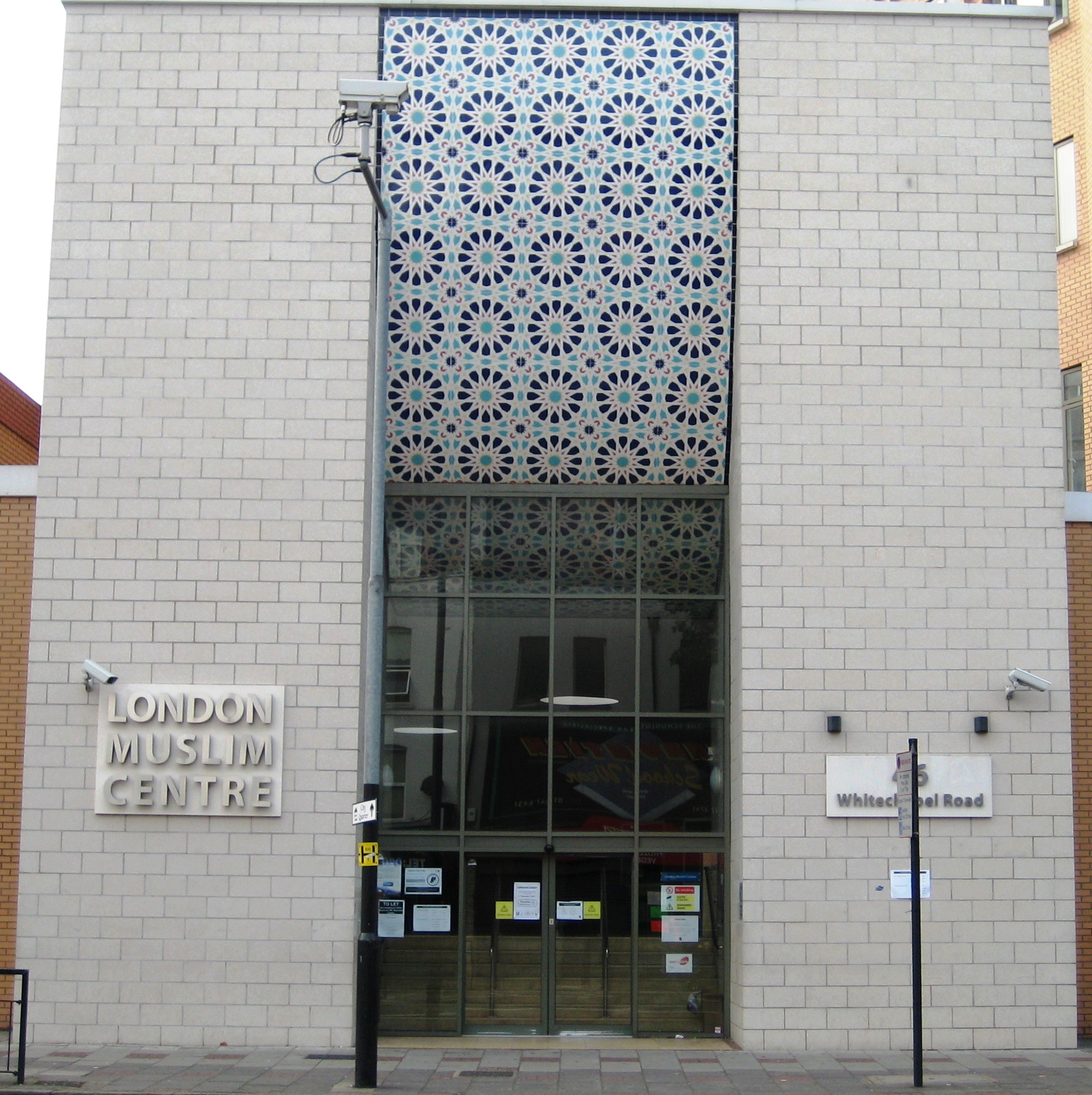|
Whitechapel
Whitechapel () is an area in London, England, and is located in the London Borough of Tower Hamlets. It is in east London and part of the East End of London, East End. It is the location of Tower Hamlets Town Hall and therefore the borough town centre. Whitechapel is located east of Charing Cross. The district is primarily built around Whitechapel High Street and Whitechapel Road, which extend from the City of London boundary to just east of Whitechapel station. These two streets together form a section of the originally Roman Road from the Aldgate to Colchester, a route that later became known as the ''Great Essex Road''. Population growth resulting from ribbon development along this route, led to the creation of the parish of Whitechapel, a daughter parish of Stepney#Manor and Ancient Parish, Stepney, from which it was separated, in the 14th century. Whitechapel has a long history of having a high proportion of immigrants within the community. From the late 19th century unt ... [...More Info...] [...Related Items...] OR: [Wikipedia] [Google] [Baidu] |
Whitechapel High Street
Whitechapel High Street is a street in the London Borough of Tower Hamlets, Borough of Tower Hamlets in the East End of London. It is about 0.2 miles (350 m) long, making it "one of the shortest high streets in London". It links Aldgate, Aldgate High Street to the south-west with Whitechapel Road to the north-east, and includes junctions with Commercial Street, London, Commercial Street to the north and Commercial Road to the east. For motorists, it is the start of the A11 road (England), A11 from London to Norwich. For cyclists, it is the start of List of cycle routes in London, Cycleway 2 from Aldgate to Stratford, London, Stratford. For pedestrians, it is a route from Aldgate tube station to Brick Lane. "Whitechapel High Street provides a transition between the commercial development pressures from the City and the historic east end communities." The street has many narrow plots with 3–5 storey buildings, rebuilt and enlarged at different times in different styles. It was ... [...More Info...] [...Related Items...] OR: [Wikipedia] [Google] [Baidu] |
Jack The Ripper
Jack the Ripper was an unidentified serial killer who was active in and around the impoverished Whitechapel district of London, England, in 1888. In both criminal case files and the contemporaneous journalistic accounts, the killer was also called the Whitechapel Murderer and Leather Apron. Attacks ascribed to Jack the Ripper typically involved women working as prostitutes who lived in the slums of the East End of London. Their throats were cut prior to abdominal mutilations. The removal of internal organs from at least three of the victims led to speculation that their killer had some anatomical or surgical knowledge. Rumours that the murders were connected intensified in September and October 1888, and numerous letters were received by media outlets and Scotland Yard from people purporting to be the murderer. The name "Jack the Ripper" originated in the " Dear Boss letter" written by someone claiming to be the murderer, which was disseminated in the press. The letter is ... [...More Info...] [...Related Items...] OR: [Wikipedia] [Google] [Baidu] |
Whitechapel Tube Station
Whitechapel is an interchange station in Whitechapel, East London for London Underground, London Overground and Elizabeth line services. The station is located behind a street market of the same name and opposite Tower Hamlets Town Hall. The station was comprehensively rebuilt in the late 2010s and early 2020s as part of the Crossrail project. The station lies between Aldgate East tube station, Aldgate East and Stepney Green tube station, Stepney Green stations on the District line, District and Hammersmith & City lines of the Underground, and between Shoreditch High Street railway station, Shoreditch High Street and Shadwell railway station, Shadwell stations on the Windrush line of the Overground. To the west of Whitechapel, on the Elizabeth line, is Liverpool Street station, Liverpool Street; to the east the line splits, with one branch heading towards to Stratford station, Stratford and the other to Canary Wharf railway station, Canary Wharf. Whitechapel is in List of station ... [...More Info...] [...Related Items...] OR: [Wikipedia] [Google] [Baidu] |
Whitechapel Road
Whitechapel Road is a major arterial road in Whitechapel, Tower Hamlets, in the East End of London. It is named after a small chapel of ease dedicated to St Mary and connects Whitechapel High Street to the west with Mile End Road to the east in Stepney. The road is part of the historic Roman road from London to Colchester, now the A11. The road had become built up by the 19th century and is now a main shopping district in the Whitechapel area. Along the road, there is an established market, Whitechapel station and the Royal London Hospital. It remains an important road and is marked with bus lanes, with limited parking. Several ethnic minority communities have centred on Whitechapel Road. The road was a focal point of the Jewish Community from the 1850s to the 1930s, with many Jewish shops and market stalls. Towards the latter part of the 20th century, the street became an established settlement of the British Bangladeshi community, who now sell a range of authentic Asian f ... [...More Info...] [...Related Items...] OR: [Wikipedia] [Google] [Baidu] |
Whitechapel Murders
The Whitechapel murders were committed in or near the impoverished Whitechapel District (Metropolis), Whitechapel district in the East End of London between 3 April 1888 and 13 February 1891. At various points some or all of these eleven unsolved murders of women have been ascribed to the notorious unidentified serial killer known as Jack the Ripper. Most, if not all, of the eleven victims—Emma Elizabeth Smith, Martha Tabram, Mary Ann Nichols, Mary Ann "Polly" Nichols, Annie Chapman, Elizabeth Stride, Catherine Eddowes, Mary Jane Kelly, Rose Mylett, Alice McKenzie, Frances Coles, and an unidentified woman—were engaged in prostitution. Smith was sexually assaulted and robbed by a gang. Tabram was stabbed 39 times. Nichols, Chapman, Stride, Eddowes, Kelly, McKenzie and Coles had their throats cut. Eddowes and Stride were murdered on the same night, within approximately an hour and less than a mile apart; their murders are known as the "double event", after a phrase in a Sauc ... [...More Info...] [...Related Items...] OR: [Wikipedia] [Google] [Baidu] |
St Mary Matfelon
St Mary Matfelon church, popularly known as St Mary's, Whitechapel, was a Catholic then after the English Reformation a Church of England parish church on Whitechapel Road, Whitechapel, London (in the county of Middlesex until 1889). It is repeatedly supposed by many works and oral histories that the church was covered in a lime whitewash, which gave the chapelry (district) its common name, Whitechapel. Around 1320, it became called Mary Matfelon. About that time it became a parish in its own right, but its priest for many years was a nominee of the Rector of Stepney. The church's earliest-known priest was Hugh de Fulbourne in 1329. Last rebuilt in the 19th century, the church was firebombed during the Blitz leading to its demolition in 1952. The nave's stone footprint and graveyard – its headstones removed – are the basis of Altab Ali Park on the south side of the thoroughfare.Ben Weinreb and Christopher Hibbert (eds) (1983) "Whitechapel" in ''The London Encyclopae ... [...More Info...] [...Related Items...] OR: [Wikipedia] [Google] [Baidu] |
London Borough Of Tower Hamlets
The London Borough of Tower Hamlets is a London boroughs, borough in London, England. Situated on the north bank of the River Thames and immediately east of the City of London, the borough spans much of the traditional East End of London and includes much of the regenerated London Docklands area. The 2019 mid-year population for the borough is estimated at 324,745. The borough was formed in 1965 by merger of the former Metropolitan boroughs of the County of London, metropolitan boroughs of Metropolitan Borough of Stepney, Stepney, Metropolitan Borough of Poplar, Poplar, and Metropolitan Borough of Bethnal Green, Bethnal Green. 'Tower Hamlets' was originally an alternative name for the historic Tower division, Tower Division; the area of south-east Middlesex, focused on (but not limited to) the area of the modern borough, which owed military service to the Tower of London. The Tower of London itself is located in the borough, adjacent to its western boundary with the City of L ... [...More Info...] [...Related Items...] OR: [Wikipedia] [Google] [Baidu] |
Royal London Hospital
The Royal London Hospital is a large teaching hospital in Whitechapel in the London Borough of Tower Hamlets. It is part of Barts Health NHS Trust. It provides district general hospital services for the City of London and Tower Hamlets and specialist tertiary care services for patients from across London and elsewhere. The current hospital building has 1248 beds and 34 wards. It opened in February 2012. The hospital was founded in September 1740 and was originally named the London Infirmary. The name changed to the London Hospital in 1748, and in 1990 to the Royal London Hospital. The first patients were treated at a house in Featherstone Street, Moorfields. In May 1741, the hospital moved to Prescot Street, and remained there until 1757 when it moved to its current location on the south side of Whitechapel Road, Whitechapel, in the London Borough of Tower Hamlets. The hospital's roof-top helipad is the London's Air Ambulance operating base. History Origins By the middle ... [...More Info...] [...Related Items...] OR: [Wikipedia] [Google] [Baidu] |
Spitalfields
Spitalfields () is an area in London, England and is located in the London Borough of Tower Hamlets. It is in East London and situated in the East End of London, East End. Spitalfields is formed around Commercial Street, London, Commercial Street and Brick Lane. It has several markets, including New Spitalfields Market, Spitalfields Market, the historic Old Spitalfields Market, Brick Lane Market and Petticoat Lane Market. The area has a long attracted migrants from overseas, including many Jews, whose presence gained the area the 19th century nickname of ''Little Jerusalem''. It was a Hamlet (autonomous area) of the large ancient parish of Stepney (parish), Stepney in Middlesex, and became an independent parish in 1729. Just outside the City of London, it formed part of the County of London from 1889 and was part of the Metropolitan Borough of Stepney from 1900. It was abolished as a civil parish in 1921. Origin and administration Toponymy The name Spitalfields appears in the f ... [...More Info...] [...Related Items...] OR: [Wikipedia] [Google] [Baidu] |
East London Mosque
The East London Mosque (ELM) is situated in the London Borough of Tower Hamlets between Whitechapel and Aldgate East. Combined with the adjoining London Muslim Centre and Maryam Centre, it is one of the largest mosques in Western Europe accommodating more than 7,000 worshippers for congregational prayers. The mosque was one of the first in the UK to be allowed to use loudspeakers to broadcast the adhan. Building details Construction of the three-storey East London Mosque began in 1982 on land left empty after bombing during World War II, and was completed in 1985. The architect was John Gill Associates. The exterior is a distinctive brick pattern in two colours, with the front facing Whitechapel Road and the rear on Fieldgate Street. The mosque is capped with a golden dome of about 8.5m diameter. The minaret rises to about 28.5m above ground level, and the main entrance is finished with two smaller copies of the minaret. The mosque has two large halls, a gallery, classrooms, of ... [...More Info...] [...Related Items...] OR: [Wikipedia] [Google] [Baidu] |
Tower Hamlets Town Hall
Tower Hamlets Town Hall is a municipal facility on Whitechapel Road, Whitechapel, London. The new structure, which has been commissioned as the headquarters of Tower Hamlets London Borough Council, incorporates the façade of the old Royal London Hospital which is a Grade II listed building. History The original hospital was designed by Boulton Mainwaring in the neoclassical style, built in yellow brick and opened in September 1757. The design involved a symmetrical main frontage with seven bays facing onto Whitechapel Road; the central section of five bays featured an arcade of round headed windows on the ground floor, a mullioned window with tracery spanning the first and second floors in the left hand bay and sash windows on the first and the second floors in the other four bays. The windows were flanked by full-height Doric order pilasters supporting an entablature and a pediment with a clock in the tympanum. The Barts Health NHS Trust, who operated the hospital, vacated th ... [...More Info...] [...Related Items...] OR: [Wikipedia] [Google] [Baidu] |







